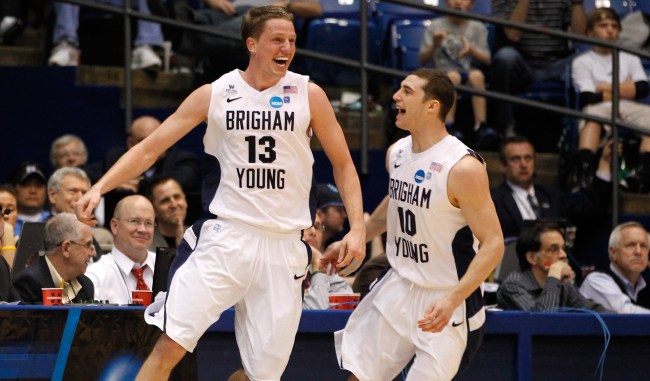
Getty Image
The NCAA Tournament has spawned a countless number of wildly memorable contests since the best teams in college basketball first faced off for a postseason showdown all the way back in 1939.
You don’t need to tune in to too many games to understand why the event is synonymous with the “March Madness” moniker Brent Musburger first deployed on CBS in 1982 while covering the action for the network.
There are a number of different factors that have played a significant role in Madness becoming the annual spectacle we’ve come to know and love.
Fans have some extra incentive to care about how things pan out thanks to the ever-popular bracket pools that play a role in the billions of dollars companies across the United States lose each year due to the tournament’s impact on employee productivity.
However, I think most viewers are more intrigued by the Cinderella stories that have routinely emerged over the years and the promise of the wildly unlikely upsets that make them possible.
Those last two elements are linked by one thread that really makes March Madness so magical: knowing that you can’t really count any team out until the final buzzer sounds.
Northern Iowa learned that the hard way in 2016 when it fell victim to what is easily the most dramatic collapse in the history of the NCAA Tournament by losing to Texas A&M after the Aggies were able to force overtime despite facing a 12-point deficit with less than 45 seconds remaining in the contest.
You could certainly argue that was the most monumental comeback in the history of March Madness.
However, if you want to get a bit more literal about the definition of “comeback,” you have to go back a few more years to a game where another team was able to escape from the biggest hole any squad has successfully dug themselves out of while playing in The Big Dance.
How BYU stunned Iona to pull off the biggest comeback in March Madness history

Getty Image
I know there are plenty of college basketball purists out there who would argue the “March Madness” label should only be applied to the 63 games that are played between the first round and the national championship and not the “First Four” that was first introduced in 2011.
When you consider the comeback in question unfolded in that qualifying round just one year after it was introduced, I know plenty of people reading this would be unable to resist the urge to send a “UMMM, ACTUALLY…” message my way if I failed to acknowledge the differentiate.
As a result, I’d like to preempt the biggest comeback in March Madness history with what is technically the second-largest one to ever transpire thanks to what went down when Duke and Maryland faced off in the Final Four in 2001.
Mike Krzyzewski and the top-seeded Blue Devils were hoping to bring a title back to Durham for the first time since 1992, while the third-seeded Terrapins were still in search of their first national championship in the history of a program that played its first game in 1904.
At first, it looked like Maryland was well on its way to punching its ticket to the final. The team pulled out to a 22-point lead in the first half, and while Duke was able to make up some lost ground, it still trailed by a score of 48-39 heading into halftime.
Unfortunately, the Terrapins were unable to stop the slide from continuing after emerging from the locker room.
The Blue Devils slowly but surely scraped back until taking a one-point lead with around seven minutes remaining in the second half, and that number continued to grow until they officially capped off the comeback with a 95-84 victory.
If you’re one of the aforementioned fans who refuse to give the First Four the legitimacy it craves, you can stop reading there (but hey, you’ve made it this far; it’s just a few more sentences).
To paraphrase Justin Timberlake’s character in The Social Network: a 22-point comeback isn’t the biggest one in March Madness history? You know what is? A 25-point comeback.
That was the size of the uphill battle Brigham Young University found itself facing in 2012 during its First Four showdown with Iona, which led by that much with a little over six minutes to go in a first half that ended with the Gaels up 55-40.
The Cougars could take some solace in knowing they were able to hold Iona scoreless for the last four-and-a-half minutes of the opening frame and crawled back a bit with the 10 unanswered points they put up during that span.
It’s safe to say BYU kept that momentum going once they stepped back out onto the hardwood.
Iona did start the second half on a 7-4 run, but their opponents went on a 13-0 run to narrow the margin to five with around 10 minutes remaining.
The Cougars completed the comeback when Noah Hartsock drilled a three-pointer from the corner to give his squad their first lead of the game with 2:25 left on the clock. They wouldn’t trail for the remainder of the contest, which ended with BYU securing the 14-seed with the 78-72 win.
Madness indeed.